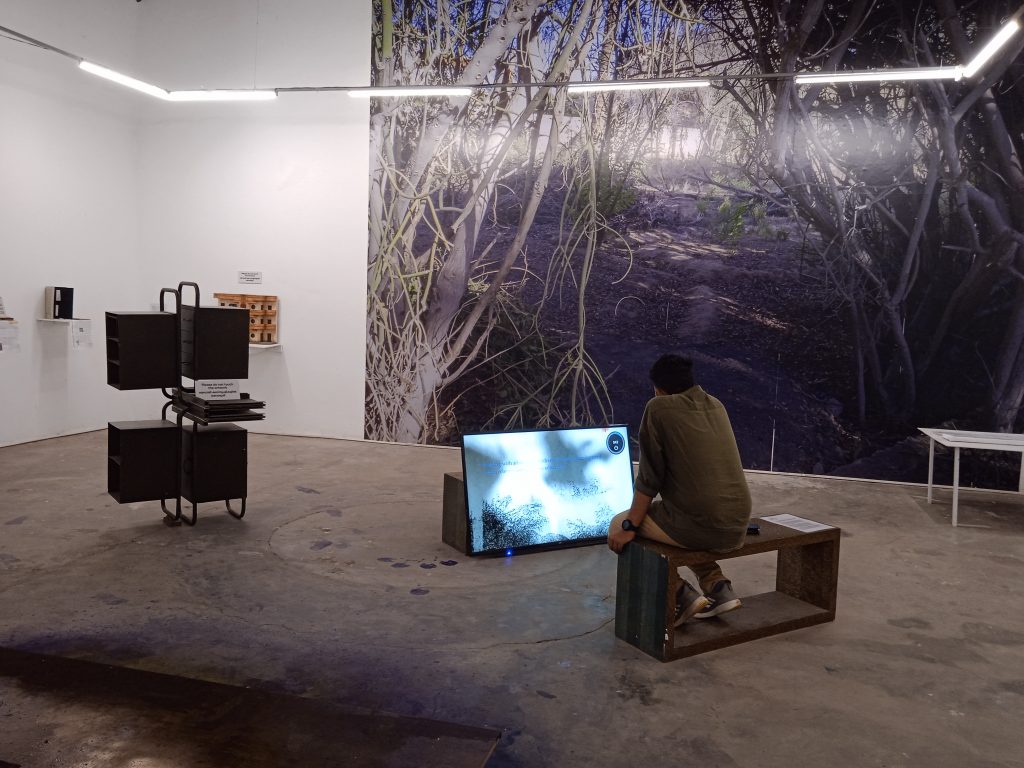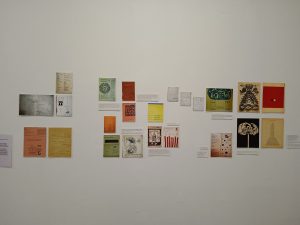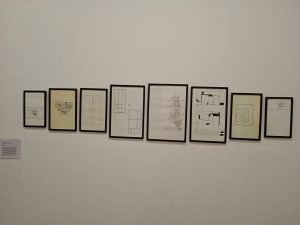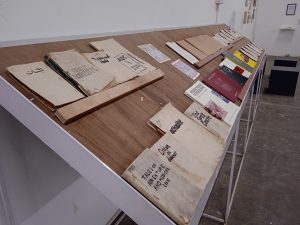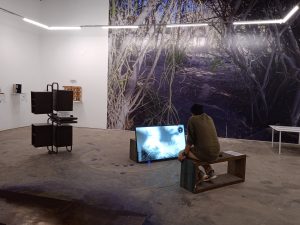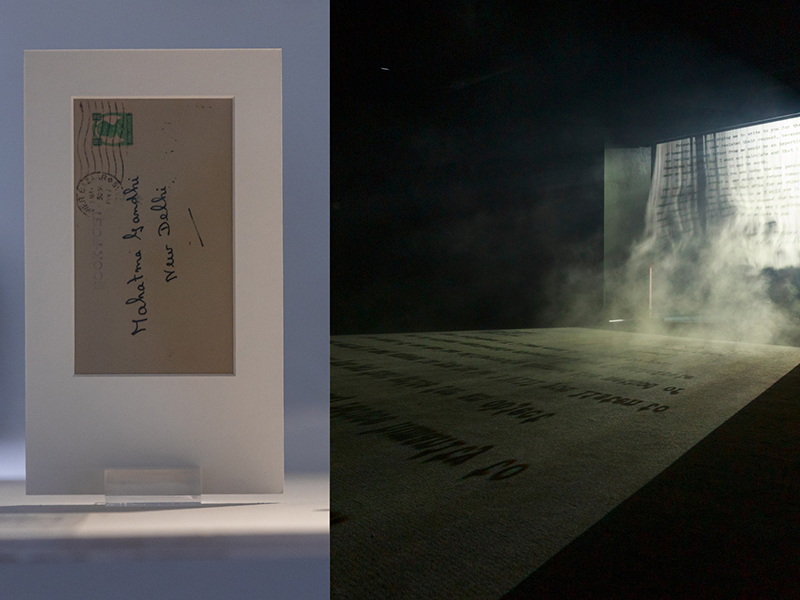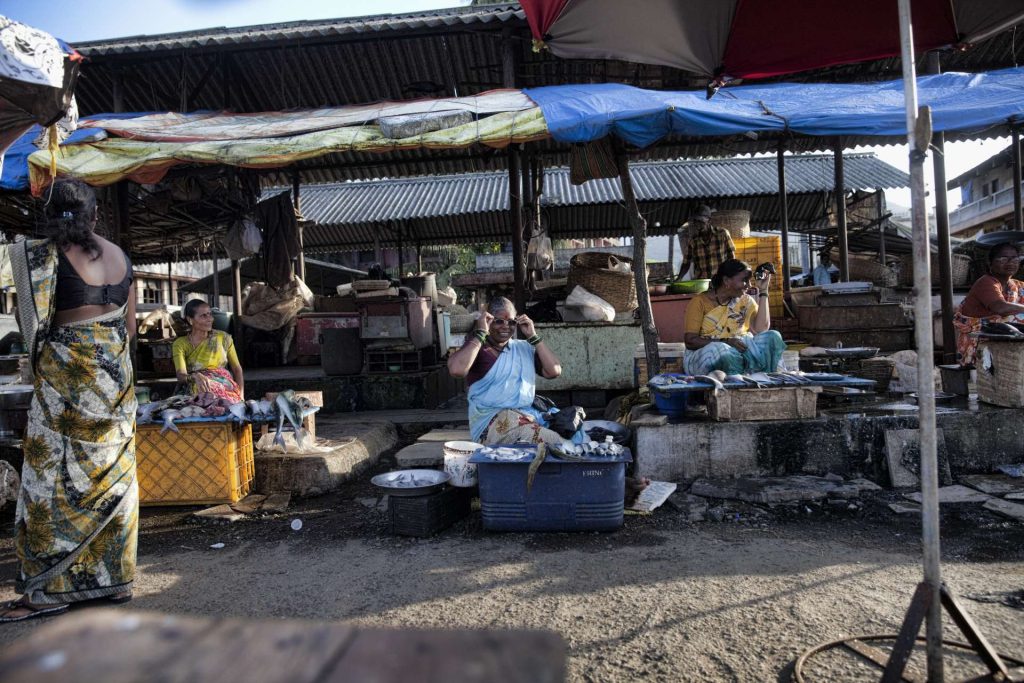Krispin Joseph PX
There is enough discussion already happening about what art is. In this western terminology, art is everything we ‘created’. Literature, Music and other creative expressions are treated as art under the domain of art. Then, there are some subdivisions of fine art or plastic art to define the materialistic art form differently. Kochi Muziris Biennale-like venues carry out human expressions from different scopes and mediums. 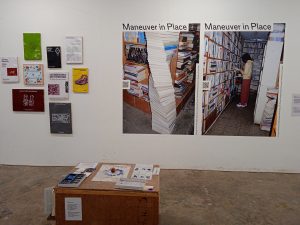
One of the shows, ‘How to reappear: through the quivering leaves of independent publishing’, brings some new art exhibition ideas. In this show, the curators, Egyptian visual artist Maha Maamoun and Amman-based artist and researcher Ala Younis, get this show to Biennale under the roof of ‘Kayfa ta’, a publishing initiative to use the popular form of how-to manually respond to some of today’s perceived needs.
This exhibition arises from ongoing research into the expanded field of publishing and attendant questions of form, language, access and right to publish. From audio publication to cement palm trees, the exhibition reflects on the malleable realm of alternative publishing practices where limits are creatively questioned and hardened practices lured to speak in different tongues, writes in the concept note.
The show is showcasing Abla elBahrawy who is an architect and researcher from Cairo, Egypt, Iranian Artists Ala Dehghan, Egyptian cartoonist Andeel, Banglore-based visual artist Anup Mathew Thomas, Friends of Elliptical Orbits, Beirut-based visual- installation- performance- video and writing artist Hussein Nassereddine, Egyptian poet Iman Mersal, Korean based film- performance- installation artist Jeamin Cha, Palestinian artist Jumana Emil Abboud, Indian filmmaker- author and curator Madhusree Dutta, Jordanian book seller Mahall al Maa, Pakistani born Banglore- based sculpture, video, digital images, text and drawing artist Mariam Suhail, German writer, director, producer and film editor Merle Kroger, worked in the German and Hindi film industries Banglore based artist Nihaal Faizal, Noopur Desai, Cairo- based photographer and artist Rana Elnemr, Raqs Media Collective, Goan based artist Sahil Naik, The state, Indian publishing collective Tara Books, Tukral and Tagra, an artist duo, working with painting, sculpture, installations, interactive games, video, performance.
What makes our contemporary social life and narrative so deep? Many things together materialise our past and present for the future; the way we create the presence of absence is outstanding. Audio-visual and textual formats of content intensely articulate the worlds of expressions in a certain way, and that material tells us the story of creative practices.
‘How to reappear: through the quivering leaves of independent publishing’, redoubling the past incidents in a visual form into a present-time audience with intense. This show is an interdisciplinary representation of different content in diverse formats, making us think of our way of seeing and the greatest travelogues of history.
Marim Suhail presents five in one category as five disparate ideas held within the book as a medium. On a short note, Mariam Suhail mentions: ‘book is a medium of art that you can approach as a familiar object’. A book is not a visual experience, so no one gets anything at first glimpse. We need to follow page by page as frame by frame, but no prior knowledge need to go, and without inhibitions, anyone can interact with it. Mariam Suhail talks about the reading experience of a book; that idea of a book starts with the cover and title that pages will follow. Reading a book is a private interaction; one can go back and forth, stop it any time, and come back. Artists think about the reader’s intention of engagement, ‘read through it, consider it, retain it or forget it. You place the book down and walk away.
In another collection, Mariam Suhail brings 14 books in permanent marker on paper named ‘Breakdown of shorter Concerns 1’. Artists started this project in 2011 in a larger volume, a preoccupation with drawing. Artists adopted drawing as a temporary medium for the last project, converted as a methodology and form in work. This exercise led her into areas of mediums to develop ideas in a fenced conceptual space, where one idea would lead to another in a sequence she did not necessarily intend or dictate.
In ‘The Complete uncredited works: the palm tree forest’ Hussein Nassereddine presents salt, concrete, and gypsum sculpted by the great Ibn Kathir’s ten-volume magnum opus ‘Al-Bidayath Wal Nihayah’ work. Only a limited number of columns are produced in this series, which builds a bridge between a great poet and contemporary society in a unique way. ‘The palm tree forest is a palm-like column cast from a mould based on the shapes Ibn Oubeid describes. Due to the exhausting process, which deteriorates the mould through repeated usage, only a limited number of columns can be produced”, writes Hussein Nassereddine in the concept note.
Noopur Desai’s Samathara Masika: Little Magazine Movement in India brings a collection of little Magazines published in Marathi and English that change the historical context of modern art discourse and visual culture in a postcolonial era. ‘The little magazine movement (the 1950s-1980s) was a small in scale but historical moment that questioned the urban elite literary and visual sensibilities, the conventions of representation, both in textual and visual imagery’, write Noopur Desai in a concept note.
This project brings movement that builds an alternative space between the urban elite and ordinary people’s creativity, independently published works in small sizes and varying formats, designs and content. Their strategies and printing style are entirely different from elite magazines, and the running route is also distinct. This little magazine wraps anti-institutional modes in range and aesthetic innovation that combines many creative practices.
‘Some of the works are part of graphic art and printmaking that renders visible a new connection among contemporary printmaking practices, innovations in printing techniques, and writing forms that took place in the 1960s in New Delhi, note the artists. Little magazine Yeru print in Bombay carries a protest and rebellious action of burning Satyakatha in the back cover printing. The magazine invited the people to protest against the established norms of publishing and writing prevalent in the Marathi literary world at that time. Little magazines disappeared because of the material they used for printing, the need for more funding for continuous printing, and the nature of the experiment. Most of the little magazines end up in scrap dealers. They are ephemeral because of their forms and innovative distribution formats like inland letters, postcards, pamphlets, wedding cards, or airmails.
We’ll not follow grammar rules, writes a little magazine back cover in 1968, these are how most little magazines are printed, so rebellious. The first of the Timb is free, but only some are paid because they need to contribute.
Anup Mathew Thomas’s publication, text and single channel digital slide works bring the idea of work and the people in a National College of Arts Library in Lahore titled ‘Well basically, this is about Thomas Jacob’. Thirteen catalogues of works were inscribed individually by the artists in the library, and most disappeared from there in a time. There are 16 cameras installed inside the library, and artists try to understand how this happens in time. ‘On the 4th May 2006, Thomas found one of the catalogues in Anwar Saeed’s studio, who had been informed during a casual conversation earlier that a catalogue had been left for him in the NCA library. However, he had picked up a copy inscribed for Lala Rukh as he could not find the one in his name, the artist.
Raqs Media Collective brings Sarai Reader into this show. Sarai Reader is an issue of media that brought academics and practitioners into a new dialogue of collaborations and interactions. Urban life and the public domain are the main focus of this project, and thinking seriously about urbanisation, media life, Cybermohalla, critiques of intellectual property, free software, art practice, language and the city and the public realm.
Friends of Elliptical Orbits produced a recording of readers selected based on potential resonance or friction, broadcasted on radioalhara.net in the time of an exhibition in a gallery space at the Hessel Museum of art.
Thukral and Tagra bring a newsletter named ‘Trolley times- Voice of Kisan protest 2020’ from the world’s largest protest; this is about real news in the time of fake news, which gives a clear idea about reality. This four-page initiative, printed in Hindi and Punjabi, focused on factual information and photographs to reach real people who need real news.
A publishing house and curatorial practice called Reliable copy are dedicated to the realisation and circulation of the works, projects, and writing by artists, published books, documents, curation, and hosting a wide variety of events. Amman-based bookshop Mahall al-Maa anonymously exchanged texts between people and researchers; the replacement covers were made for books that had lost theirs.
Rana Elnemr’s vertical shadow library exhibits a poster and installation in the show accompanied by a firesticks tree and a prayer, thinly cut lines from photocopies of book pages and letters from prisoners. These letters and drawings are laid on craft paper, rendering a shadow for the commonly domesticated tree in the wilderness, where it grows into large shrubs.
Nihaal Faizal carries a 5-panel board, a public record document, and laminated C-type prints, bringing attention to the right to information act passed by the parliament of India in 2005. This act assures the accuracy of the legal actions; any ordinary citizen of India is entitled to request information from any public authority at a minimum cost of money; daily, there are 4800 RTI applications filled, and a response is expected within 30 days. ‘RTI/1242/2021-PMR is the official response received by the artist to his Right to Information request filed with the prime minister’s office concerning information on the artworks displayed in the state-sponsored residential premises of the Indian Prime Minister, Narendra Modi’, write in a note. Rana Elnemr’s second work is a ten mins video, ‘the Firesticks library,’ which is a conversation between artworks, books, friends, buildings and trees about making spaces from the imaginary, making books from trees, spurring life into words and paintings, across time and space.
Sahil Naik’s Modernist Facades for New Nations demonstrate ‘development’ and ‘internationalism’ in newly liberated nations, placing facade over the facade and floor plan over the floor plan. Then try to understand the matching patterns and determine structural similarities between shelved, demolished, compromised or now threatened structures.
These works from different media and forms bring many things together and discuss the abstract pattern of the temporary social life and the world. How we reach here is not only determined by the visual or any art; textual and other modes of practice help us come here.

Krispin Joseph PX, a poet and journalist, completed an MFA in art history and visual studies at the University of Hyderabad.

